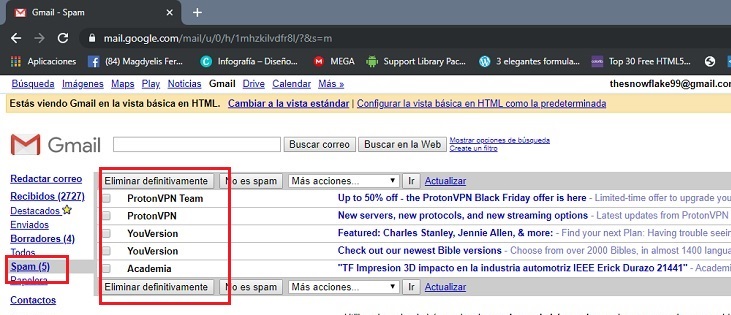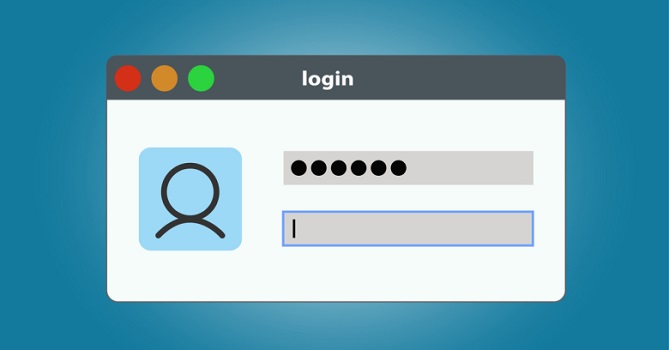
Index:
UPDATED ✅ SPAM is all those unwanted messages or emails with advertising content and even malware ⭐ ENTER HERE ⭐ Learn more
When a person creates an email account, they do so in order to exchange messages with their acquaintances or friends. But, you should know that when you have it it is common for dozens of messages to be received that were never requested and that are not in our interest.
These emails constitute the very famous “Spam” that we have all heard about as Internet surfers. This phenomenon is increasing day by day, and as new solutions and technologies emerge to counter it, dedicated spammers are becoming more sophisticated and modifying their skills, in order to avoid user countermeasures.
In order to inform you on this topic, in the following article we will give you some details about spam and the types that exist. Also we will explain you better the purpose for which many practice this phenomenon and how to recognize it.
What is SPAM or junk mail and what is its purpose?
SPAM is the way of oversaturating the Internet with many copies of the same message, with the aim that these reach people who otherwise would never agree to receive them.
Originally this word cataloged those spam or junk mail that arrived unsolicited, however, the concept has been expanded by the multiple forms of online communication that exist today.

Usually, this propaganda is sent in bulk to millions of accounts at the same time, and instead of investing in campaigns and ads on popular web pages, most advertisers take advantage of this medium and collect email addresses from public or private sources, to which they will subsequently send promotional emails in a matter of minutes.
Making a sizable profit if just a small portion of these recipients end up buying the product. Notably Spain with 0.7% occupies the nineteenth position of the top 20 from major spam-emitting countries.
As a curious fact we mention that the terminology “Spam” has its origin in the Second World War, when the American company Hormel Foods launched its canned meat called “Hormel’s Spiced Ham”, which means spiced ham. From whose contraction the word in question arises.

This food was very popular with American and British troops as it saved the use of the can opener. But, it is in 1970 when the kings of British humor, The Monty Python’s in their skit, describe it as annoying, repetitive and unavoidable.
This in view of the fact that when trying to order food in a cafeteria, all the dishes on the menu contained the food, which became somewhat invasive.
That’s when almost half a century later, this description is not funny at all and it fits perfectly with those emails or advertising mailings that are received on the Internet.
What are the main forms of SPAM that exist?
Like we have already said, all ads, images or links can be considered spam that we often find on websites. But what ways are there to find it?
Here we mention them:
adult advertising
It typically includes offers for products designed to increase or enhance sexual potency, erotic or pornographic advertisements that direct the user to paid or subscription sites.

phishing
It is an illegal data collection technique that consists of duplicating web pages making the user believe that they are in the original. This is commonly done with bank pages where notices are sent for them to access them. In this case, what the hackers do is update data such as passwords, expiration dates, account numbers, etc.

Propaganda about health and medicine
They are carried out by miraculous products, magical therapies or shamans who say they outperform medicine and nutrition specialists. These are usually published in magazines that use “before and after” montages.

Computers and the Internet
It includes hardware and software offers, as well as services aimed at website owners, such as hosting, web optimization, domain registration and many more.

Advertising about finances and economic opportunities
They usually offer insurance of all kinds, debt reduction services, low interest rate loans and investments that seem advantageous. The desire to have a stable economic life makes many fall for this type of propaganda.

Messages about educational and professional content
They usually arise in economic crises and when unemployment increases in a population. They make offers for seminars, training and online degrees that will allow them to access guaranteed jobs in exchange for apparently nothing.

On which platforms can we find spam?
As there are no perfect anti-spam measures that completely protect a communication medium, no platform is exempt from suffering from this problem that spreads not only in the most popular, but also reaches the least frequented and more private that exist.
In what follows, we will show you the most bombarded by the topic in question:
Forums
It is also considered spam when a user posts something that has nothing to do with the topic of conversation in the group. Likewise, when a person repeatedly posts solely for the purpose of increasing their rank or number of posts on the forum.

Social networks
These consist of sending invitations, job offers, among other unsolicited advertising. Adding to this comments on social networks, blogs or videos of Youtube that do not add anything to the content and are only looking for a promotion, new subscribers or a link.

SMS
This is known as the one that is done by telephone through the operators through text messages. That is to say, it is all that advertising communication in which there is no prior consent. In the same way, this is considered unsolicited commercial communications.

chat
Generally, this is reflected in social network chats, and consists of repeatedly posting the same thing so that messages from other members cannot be read. They are chains where instructions or promotions of a product are given.

calls
Spam is also called the calls made by telephone companies at any time, or from organizations that seek your participation in certain contests.

Unsolicited communications on the fax
Although at first it was not considered spam, they are currently also punished by the Spanish Data Protection Agency, since sending this type of message goes against the General Telecommunications Law and data protection regulations.

street ads
Although it is not a platform, we can mention it as one of the ways to find this, especially in cities, since it is very common to find advertisements stuck on walls, posts, cars, among other structures while walking. In the same way, we can witness this when they make us take a piece of paper almost out of obligation where something is described that we may not care about.

Risks of SPAM on the Internet Why is it so bad?
This pile of junk mail is not only annoying in that the mailbox fills up with unwanted messages, but also it can also become very dangerous.
While it is true that this does not belong to the group of virtual attacks and is most often used for marketing purposes, many cybercriminals can also use it as a means of delivering malware to devices and steal access data to user accounts. In particular to online banking services through techniques of phishing or identity theft.
More than 40% of spam is aimed at stealing personal information for illicit purposes, which can cause significant financial damage to the user. For this reason it is evident that it is not always for commercial purposes.

We can basically classify online criminals into two groups. Scammers who send misleading advertising or sell “miracle products,” and hackers that use emails as a means of distributing viruses that can give them full access to the recipient’s device.
How can I protect myself from spam messages and emails?
Shipping this is considered worldwide as good manners, but As we have already mentioned, there is no measure that provides perfect protection against it. Therefore, you must decide which of the possibilities presented below is the most applicable. to stop receiving spam messages:
- Use alias accounts: do not use your primary email account in newsgroups, guestbooks, or forums; if not that uses alias accounts that you can delete after using them. You should only broadcast your private account to people you really want to communicate with.

- Implement anti-spam software on your computers: you have the possibility to configure your account in such a way that all incoming messages are rejected by anti-spam software. They have built-in smart software filters to recognize these messages and move them from your inbox to your spam folder.

- Be careful what you click: You should not reply to spam messages, nor click on links, files or images in them, because they may contain dangerous scripts and this way they will also have the possibility to verify that your account exists, which could result in an increase in spam.

Emails